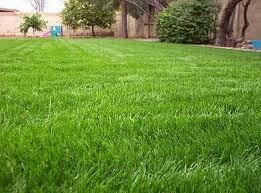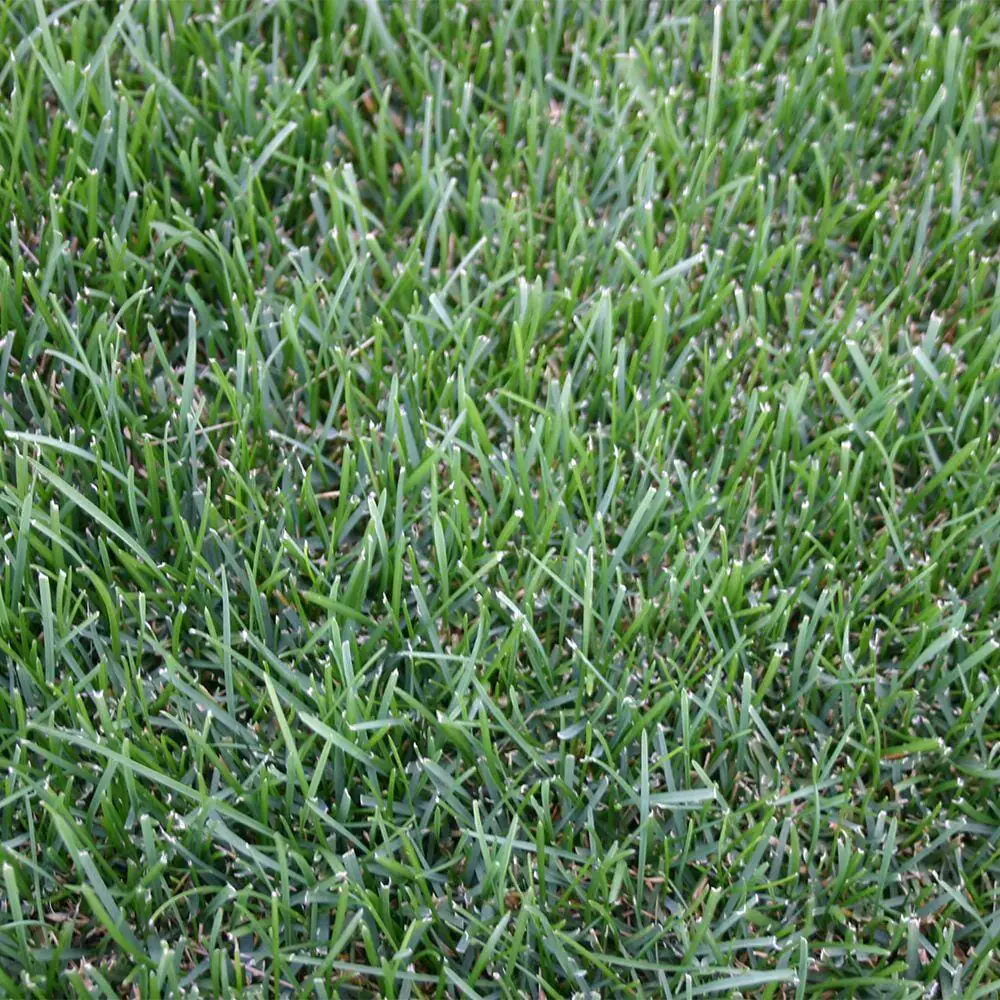Last Updated on January 18, 2023 by Grow with Bovees
Everyone wants a thick, lush green lawn, but not everyone has thousands of dollars to splurge on installing new grass sod.
Planting grass seed is a budget-friendly way of establishing a new lawn or repairing a damaged lawn.
However, the biggest question about growing grass from scratch, is how long does grass seed germination take?
Seeds for lawn grasses, as a general rule, take between one and two months to grow from grass seed to lawn.
However, it is worth noting that there are several factors that can influence how fast grass grows, including; the grass type of grass seed, the handling and storing of the seed products, the weather, soil temperatures, and the soil itself.
Grass Seed Type
The first thing to understand is that not all grass seed types germinate at the same rate, where some grass plants can take as little as five days to sprout, others can take up to 30 days.
The age of the seeds can also affect their growth rate, so you should buy grass seeds that have been packaged as recently as possible.
Typically, grass seeds offer a two-year shelf life. Even though expired seeds won’t actually damage your lawn, they won’t be worth the effort of sowing them, because they simply won’t grow!
The easiest way to check if seeds are still viable is to sprinkle a teaspoon full on a damp piece of folded cotton or thick tissue, and put it into a plastic bag, then observe them for the expected germination period to see if they sprout. If they sprout, then you know you’re good to go with sowing the whole batch.
Different grass types are suitable for different climates and soil types.
Below are some common types of lawn grass seed, along with guidelines as to the time it takes for them to germinate.
To add variety to your lawn or landscape, you can mix grass seeds together or buy premixed grass seed packages at your local gardening store or nursery. However, it is not recommended to mix cool-season grass seed and warm-season grass seed varieties together.
Cool-Season Grass Germination Time
Cool-season grass germination time can vary depending on the type of grass and the growing conditions of the soil. In general, cool-season grass germination times range from three to seven days, depending on soil temperature. If you need to water often, then you can expect germination times to be shorter, while on soil that is allowed to dry out will take longer.
While some grass seeds germinate immediately, others will start the germination process better after a period of dryness to allow for the seed coat to break and expand.
Cool-season grasses are the fastest to grow from seed when soil temperatures are between 60 and 75 degrees. When properly cared for, cool-season grasses can go from seed to a lush lawn quite quickly.
Annual Ryegrass Germination
Annual rye grass is a very easy grass to grow from seed. You see fast results when you plant annual ryegrass seed, it germinates in as little as five to ten days, and it will stay green all year round, in all but the harshest of climates.
It is slightly more difficult to grow from seed than hybrid rye grass or perennial ryegrass seed, but it is still a relatively stress-free grass to grow, but it is not over tolerant towards the cold.

Perennial Ryegrass Germination Time
This is a popular choice for lawns, thanks to its ability to handle a lot of foot traffic, as well as heavy equipment, and it’s quick germination time of roughly five to 10 days. From its colorful, fine-textured leaves to its dense, weed-suppressing growth habit, this versatile plant is a great choice for backyard gardens.

Bentgrass Germination
Bentgrass is a type of perennial grass that is dominant on golf courses, taking approximately two weeks to germinate. It also grows in clumps and is a popular choice for home lawns as well. In order to germinate the seed, a sterile medium such as sand must be used. In addition, a cover must be used to keep the soil moisture, and to reduce the amount of light that reaches the seed. This is important because the seed requires darkness in order to germinate.
Kentucky Bluegrass Germination
Kentucky Bluegrass is a heat and drought tolerant grass, making it an ideal choice for cool season lawns, but can take a bit longer to germinate between 10 – 21 days.
Many homeowners choose to plant Bluegrass seeds to have a lawn which will require less water and less maintenance. Bluegrass will not take over your lawn and is less aggressive than other grass types. It also has fewer disease and insects issues than other types of grass. It is also excellent for sports fields, and can withstand lower air temperatures.

Tall Fescue Germination Time
This grass species takes 7 to 12 days to germinate.
Red Fescue Germination Time
A cool-season grass that doesn’t require much water, does well in shade, and takes 12 – 25 days to germinate.
Warm-Season Grasses
Warm-season grasses take longer than cool-season grasses to germinate, and develop roots. As the name suggests, warm-season grasses do well in hot weather, and germinate faster at temperatures between 80 and 95 degrees Fahrenheit.
Zoysia Grass
Zoysia grass is a popular choice of warm-season grass and can handle foot traffic well. Zoysia takes 14 – 21 days to germinate and will tolerate partial shade and full sun fairly well.
Bermuda Grass
This grass is valued for its exceptional heat and drought tolerance, making it very popular for warm season lawns, but the seeds germinate over a period which has quite a wide variation of between 10 and 30 days.
Centipede Grass
Another great heat tolerant warm-season grass, Centipede grass is a favorite for lawn owners looking for minimal upkeep and the newly planted grass seed takes between 14 and 21 days to germinate.
Buffalo Grass
Native to North America, Buffalo grass is drought tolerant, and is a low maintenance grass that germinates in 14 to 30 days.
Best Time to Plant Grass Seed
Grass grows the fastest when the time you plant it aligns with the seed’s natural planting season. Spring is generally a good time to plant many grass species, but there are exceptions.
Cool-season grasses such as; Perennial Ryegrass, Kentucky Bluegrass, and Tall Fescue, grow well during the cool temperatures of late summer and early fall. Warm-season grasses such as Bahia, Zoysia and Centipede grow fast and well when planted during the warmer temperatures of late spring and early summer.
Things to keep in mind regarding the timing and temperatures when planting grass seed:
- Refrain from planting warm-season grasses if there’s a chance of frost within the coming 60 days, when the cooler air temperatures are due to hit.
- Most, if not all, cool-season grasses grow well in daytime temperatures between 60 and 75 degrees.
- Bear in mind that it’s too late to plant any lawn grasses when the soil temperature drops below 50 degrees.
Preparing Your Lawn Before Planting Grass Seed
Whether you’re planting a new lawn or repairing an existing lawn, there are a few things you need to do in terms of preparation in order to ensure that growth is not adversely affected.
First thing to do is kill any existing weeds in the soil, and if you’re going to use chemical weed killer products for this task, remember that there is a transition zone between their application and the seeding of a new lawn.
However, it is generally better for the environment and your lawn if you can find a natural way to kill weeds and this will also negate the need to wait after the remedy products have been applied.
Secondly, if there are any tree roots above the ground in the area to be planted, make sure to remove them in the proper manner.
Thirdly, you should create a welcoming environment for the new grass seedlings. This you can do by getting rid of any rocks or debris in the soil, and carving out a smooth seed-bed. Next, spread a one to two-inch layer of compost over the surface and till it into the top inch of the soil, then water well to a depth of six to eight inches.
Finally, sow the grass seed evenly, and avoid any foot traffic until the first mowing.
Watering New Grass Seed
When contemplating the watering of new grass seed, the first thing you’re probably thinking of using to get the job done, is a sprinkler.
But, beware! This could potentially leave you with a very messy lawn. Lawn sprinklers can pour excess water on your grass seeds, causing them to wash away or float around… culminating in clumps of grass with bald patches of soil in between.
So, how much water does new grass actually need and what is the best method of delivery?
Well, here we do have a bit of a dilemma, because an insufficient supply of water will dry out your grass seeds, and too much water will drown them. You need to keep the seed moist.
Preparation, again, is key here. What you need to do is create an ideal moist environment for the grass seeds to germinate so, as we said above, start off by watering well to a depth of six to eight inches several days before sowing.
After you’ve planted the seeds, you’ll need to water the seeded area regularly with a hosepipe on a very fine spray setting, constantly changing the direction in which the nozzle is pointed, being careful not to let any puddles form (this is where your smooth preparation surface will stand you in good stead).
The best time to water your lawn is in the morning, and of course you can skip watering if you receive sufficient rainfall to keep the soil moist.
The best time for fertilizing a new lawn is another subject that we cover here.
Final Thoughts About How Long Does Grass Seed Take To Grow
After following the above advice, all you then have to do is wait for your grass seedlings to grow. As mentioned earlier though, grass seed species grow at different rates, so the first signs of young grass could be within 5 days but could also take up to a month.
The time it takes for grass to grow also depends on the growing conditions that it is presented with. Environmental factors may be the primary factor in this regard, but your own patience and attention to aftercare could ultimately play a larger role.
When the grass reaches 2-3 inches tall it should be mown, and by no more than 1/3 of its length in order to protect it from decay. Lawn care is just as important as the seeding and growing process, because improper lawn care can result in a dead lawn in a very short period of time, negating all of your initial hard work.
